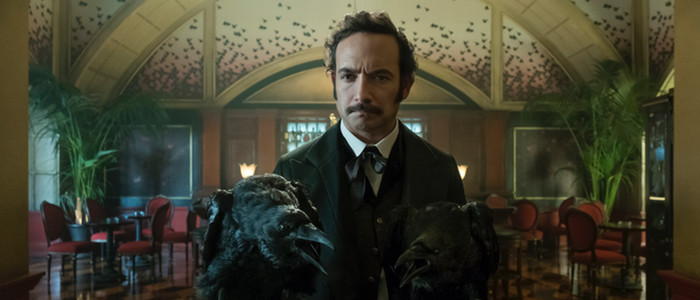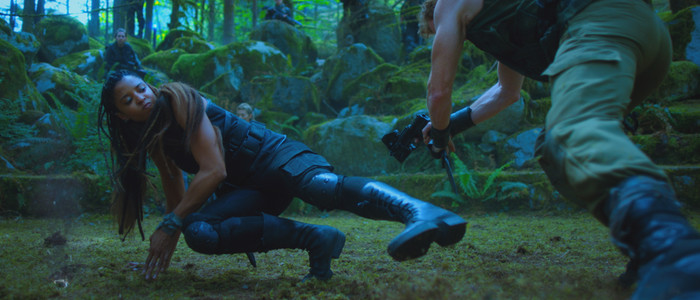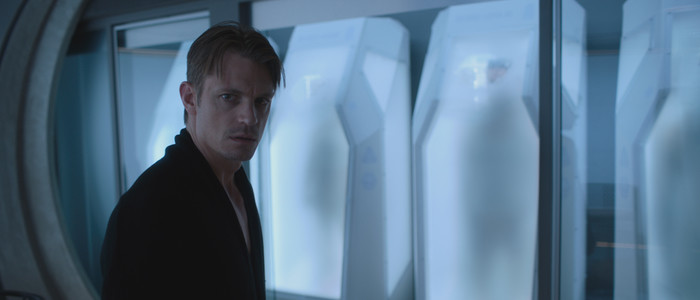Netflix's 'Altered Carbon' Is A Visual Feast Lacking Sustenance
A Visual Feast Lacking Sustenance
Netflix's bombastic new sci-fi action-drama Altered Carbon comes barreling out of the gate with little or no regard for logic. Here is a show with a rich, complex, confusing mythology that doesn't give two s***s about catching the audience up. Instead, it lays into the viewer, and unfolds a wild, exciting, downright energizing first episode full of jaw-dropping moments and bold decisions.And then proceeds to blow it.Adapted from the novel by Richard K. Morgan, Altered Carbon, created by Alita: Battle Angel co-screenwriter Laeta Kalogridis, is a visual feast, with nearly every inch of every frame seemingly tailor-made to show up as part of the One Perfect Shot Twitter account. Like another visually sumptuous Netflix series, The Crown, so much effort has been poured into creating the world of this show – a distinct, neon-drenched, cyberpunk-infused world where nearly every dollar of the budget is up on the screen. Alas, everyone was so obsessed with getting the look of this show right that they forgot to focus on the story.Set more than 300 years in the future, the world of Altered Carbon is a world free of death. Human beings can seemingly live forever with the help of alien technology that downloads a person's consciousness (or soul, if you will) into a little disc dubbed a stack. When the current body, or "sleeve" as everyone calls them, you happen to inhabit dies, due to old age or, more likely, violent trauma, your stack can be slapped onto the back of the neck of a new sleeve, and you're back. In other words, you live, you die, you live again, to quote a far-superior tale of futuristic entertainment. It's a neat concept, but it also inadvertently lends an unintentional nihilism to the proceedings. Characters can beat, bludgeon and behead each other with very little consequence. Eventually, the show starts to make a statement about this – certain characters start talking about how they need to rebel against immortality and accept death, as this method of eternal life has only made the wealthy more wealthy and the powerful more powerful. But for the most of Altered Carbon's runtime, the show treats life itself indifferently. It doesn't matter how much torture or destruction a physical form endures – a new body is just a sleeve away.So why should we even care what happens to anyone on this show, if the stakes are so low?It's a problem Altered Carbon doesn't quite know how to address, and as a result, it never even tries. Instead, the series is content to be a slice of future-noir borrowing heavily from the Blade Runner playbook. Takeshi Kovacs (Byron Mann) was once a super soldier fighting against the new world order. Then he got himself caught by the powers-that-be, and had his stack locked away in solitary for centuries. Now, Kovacs is brought back to life in a brand new sleeve – that of a dead cop, played by Suicide Squad's Joel Kinnaman.Right away, you've likely spotted a big problem. Altered Carbon is trafficking in the same exact form of whitewashing that plagued the ill-advised live-action remake of Ghost in the Shell. The original Kovacs is an Asian man now trapped inside the body of a white man. Why, exactly, Netflix thought it was a good idea to go ahead with this concept after so much justified outcry arose around Ghost in the Shell is a mystery, but here we are.To Altered Carbon's credit, it gives Kinnaman and Mann almost the same amount of screentime. While Kinnaman's Kovacs is usually front-and-center, Altered Carbon features extensive flashbacks in nearly every episode giving Mann's O.G. Kovacs (as he's called in the credits) plenty of time to shine. Still, the specter of whitewashing is hard to shake off.Kovacs has been brought out of hibernation to help solve the "murder" of super-rich bad guy Laurens Bancroft (James Purefoy). The "murder" is, of course, subjective, since Bancroft is up and walking around in a new cloned sleeve. As plot devices would have it, Bancroft can't remember who murdered his previous sleeve, and so now Kovacs must play detective to get to the bottom of it.Sort of.
Things Fall Apart
Here's the thing: once Altered Carbon sets this murder-mystery storyline up, it promptly forgets it, and instead delves into one set-piece-laden episode after another. After a while, one gets the sense that this show merely exists to show off a super cool special effects reel, and little else.It doesn't help that Kinnaman, who lumbers around the rain-soaked sets like a very handsome version of Lurch from the Addams Family, lacks the charisma required to lead the show. This distinct lack of charm is all the more apparent when the show focuses on the O.G. Kovacs – Mann is a better actor, and I really wish the show had just let him be the lead instead.So does anything actually work here? Yes. The aforementioned look of the show is almost enough to make Altered Carbon highly watchable. You can easily put this show on mute and stare at all the stunning visuals and not come away disappointed. But that's not the reason people watch TV (at least, I sure as hell hope not). Pretty pictures do not a good show make.The element that works best here is the ever-changing mythology and world building. Unlike some other sci-fi properties, Altered Carbon doesn't want to hold your hand and walk you through its brave new world. Instead, it pushes you head-first into it all and dares you to find common ground to stand on.It's the little touches that work best: subplots involving hired help fighting to the death for the prospect of being upgraded to better sleeves; a society where the wealthy have learned to exploit their immortality to make themselves even more obscenely wealthy; a Día de Muertos celebration in which people who refuse to have their stacks uploaded to new sleeves celebrate life as something finite rather than infinite. These exercises in world building go a long way to making Altered Carbon different and interesting enough to stick in your brain.
The supporting cast around Kinnaman helps, too. Martha Higareda, playing Kovacs' default partner Officer Kristin Ortega, is no-nonsense enough to become endearing. She punches and smashes her way through scenes, yet also occasionally slips into a vulnerable-enough state to remind us she's human. Ato Essandoh, as a sort-of friend/sort-of sidekick to Kovacs, is very good as well, although the script requires him to mostly stand around waiting for the action to find him.
Two standout performances come courtesy of minor, secondary characters. Chris Conner is an absolute hoot playing a sort of A.I. Edgar Allan Poe, the proprietor of a virtual reality hotel called The Raven. Conner finds just the right note of pretentiousness mixed with aloofness to make the character memorable. On paper, Poe – who is frequently butting into situations and insisting he's more of a help than he actually is – might seem insufferable, but Conner makes it work. Then there's Matt Frewer, playing an illegal sleeve salesman. Frewer lets his wardrobe and makeup do most of the heavy-lifting – he's decked-out in a shiny suit and a mountain of hair – but he's clearly having a blast playing the deliberately over-the-top character.The best work in the entire run of the series, however, belongs to Hamilton's Renée Elise Goldsberry, playing the tough-as-nails soldier who helped train the O.G. Kovacs. Goldsberry brings a physicality to her performance that's matched by a fierce intensity – she looks as if she's one second away from snapping, at all times. It's one hell of a dynamic performance, and Altered Carbon would've been a truly fantastic show if it had forgotten about Kovacs all together and focused on Goldsberry's character. Alas, she's relegated to a supporting part that finds her giving pep talks in flashbacks and appearing as a ghostly memory in the current timeline.
Blah New World
What truly keeps Altered Carbon from getting off the ground is its failure to commit to a single thread. The mystery of who killed Bancroft is never all that interesting, and the show clearly knows this because it keeps going off into new directions. Unfortunately, none of those other directions yield more rewarding results.A running subplot about a madman who wants to kill Kovacs for murdering his brother (actually his clone) is so repetitive that it's annoying. Then there are subplots about social climbers willing to bend the rules to get to the top; a corrupt police force; a mystery from Ortega's past; a storyline involving the daughter of Essandoh's character; a company that seems to exist solely to torture people; and so on, and so forth. None of this is enough to keep the show working. Things fall apart. The center cannot hold. And it certainly doesn't help that the characters are stuck spouting hokey, sci-fi jargon like, "Escape the construct!" and "Don't make me blow your stack!"After a while, it becomes clear that the reason Altered Carbon is taking its time unfolding its mythology is because that mythology is all the show has. Without it, the narrative threads that connect the multiple, often confusing storylines would be lost like tears in the rain. This is, perhaps, a problem carried over from Richard K. Morgan's novel, but a strong showrunner would've found a way to make it all work.Still, it's hard to deny the amount of work that went into this show. Altered Carbon is clearly no mere hatchet job; it's not some slapdash show quickly rushed to air without a second thought. Yet somehow, the series can't maintain itself.Ultimately, your enjoyment from Altered Carbon will come down to how much you want out of it. If you're looking for nothing more than a series of cool action scenes set against some stunning backdrops, you'll likely come away satisfied. If you crave some sort of depth to go along with all that beautiful imagery, however, you're out of luck.Nonetheless, I keep coming back to that first episode. I sat watching, stunned, my jaw almost on the floor at the audacity on display. There are moments in the first episode of Altered Carbon that rival, and indeed exceed, moments in most big screen blockbusters. It's an invigorating start, full of sound and fury. I should've realized it was signifying nothing.
***
Altered Carbon premieres February 2, 2018 on Netflix.

